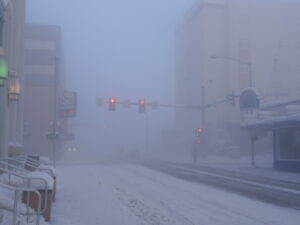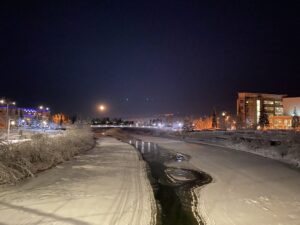
The Alaska Department of Environmental Conservation is asking for another year to come up with a plan to address the longstanding problem of particulate air pollution in the Fairbanks North Star Borough.
In a letter sent to the Environmental Protection Agency’s Pacific Northwest administrator, DEC Commissioner Jason Brune asked for the extension and said the federal agency’s proposed requirement for better pollution controls at Fairbanks-area power plants and other large sites will drive up the local cost of living without providing meaningful environmental benefits.
New scientific evidence shows that power plants and similar sites contribute only a small amount of particulate pollution and should therefore not be part of the state improvement plan, or SIP, that is required to address Fairbanks’ air-quality problems, Brune said in a news release issued Tuesday.
“The information from this new study cannot be ignored; therefore, our hands are no longer tied,” Brune said in the news release. “Hopefully this illustrates what we’ve been saying all along — EPA’s proposed decision is nonsensical. Given the new science, we’re asking that EPA give us a year to develop a revised SIP.”
Because of the fine particulates that are frequently trapped in stagnant air created by Fairbanks’ wintertime atmospheric inversions, the borough has been out of compliance with Clean Air Act standards for several years. Addressing the “noncompliance” for particulate pollution requires the periodic state improvement plans to be submitted to the EPA.
The modeling information presented in Brune’s letter is preliminary, an offshoot of an ongoing collaborative research project called the Alaskan Layered Pollution And Chemical Analysis, or ALPACA, said Jason Olds, DEC’s director of air quality.

The department has been at odds with the EPA for months over the federal agency’s mixed verdict on the latest state improvement plan.
The EPA in December proposed partial approval of the plan, lauding the elements that deal with woodsmoke pollution, but proposed partial rejection of the plan, citing a failure to address air pollution created by coal-fired or oil-fired power plants and other large sites categorized as “point-source” emitters. In its evaluation, the EPA said the state needed to require the best available technology at those sites or, in the alternative, provide justification for not requiring that technology. While wood-burning stoves have been major sources of particulate pollution, the combustion of coal, fuel oil and diesel contributes by producing sulfur dioxide, or SO2, and those sources should also be addressed in the plan to improve Fairbanks-area air quality and, consequently, alleviate some public health problems there, according to EPA’s evaluation.
The state position is that most of the Fairbanks-area wintertime particulate pollution is from smoke from wood stoves used for home heating and that the improvement plan should focus squarely on that. In the community of North Pole, a part of the borough especially affected by particulate pollution, 60% to 80% is from wood-burning stoves, according to the DEC news release issued Tuesday.
The new modeling information, though preliminary, bolsters the state’s argument, Olds said. Previously, he said, “the science did not exist to produce these results. It does now.”
A spokesperson for EPA’s Seattle-based regional office said the agency will consider new scientific information as it works through the new plan for Fairbanks.
“For years EPA has been working collaboratively with DEC on better understanding the science behind the PM (particulate matter) problem in the Borough. A critical piece of this work is to use increasingly sophisticated technical tools, including new air quality models, to develop a thorough understanding of SO2 sources in the area and how they contribute to the fine particulate matter problem,” Bill Dunbar, a public information officer, said by email.

“EPA is as determined to get this area to attain the health based standards as DEC and the Borough are,” Dunbar said. He added that as the agency reviews the state’s current plan, it will work with the state on on the technical analyses necessary for the state to develop a new plan that address area public health challenges.
Over the past two decades, Fairbanks-area residents have significantly reduced wood-stove pollution through various programs, even though levels remain above Clean Air Act standards. Better technology is a factor; by 2022, per-stove particulate emissions in Fairbanks were less than a quarter of what they were in 2010, according to federal and state data.
There have been problems in the past with the EPA’s program that certifies wood-burning stoves. Lack of proper oversight may have resulted in some substandard stoves receiving certification, according to a report issued by the agency’s inspector general earlier this year.
Last month, Alaska joined with nine other states in filing a notice of intent to sue the EPA to compel a revised stove-certification program.
Whatever steps are taken in the future, solving the Fairbanks North Star Borough’s air pollution problems will be difficult, warns one recently published study.
Natural conditions combine to create stagnant surface-based atmospheric inversions, which “are not a modifiable factor,” the ALPACA study said. Those conditions are the physical terrain – the nearby mountains that rim low-lying areas – the cold winter temperatures and the lack of sunlight that, at lower latitudes, would send some heat into the air and promote mixing, said the study, published in January by the Royal Society of Chemistry.
“This means that cleaning up air quality in Fairbanks will always be a heavier lift compared to similar mid-latitude cities, given how magnified emissions become in a shallow boundary layer when dispersion is low,” the study said.
Alaska Beacon is part of States Newsroom, a network of news bureaus supported by grants and a coalition of donors as a 501c(3) public charity. Alaska Beacon maintains editorial independence. Contact Editor Andrew Kitchenman for questions: info@alaskabeacon.com. Follow Alaska Beacon on Facebook and Twitter.




